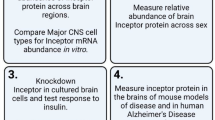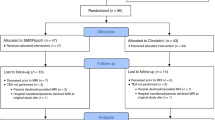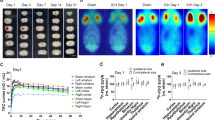Abstract
Background
Children with asymmetrical fetal growth restriction (FGR), whose head size is relatively preserved, often have a poor neurodevelopmental prognosis. Insulin receptor isoform A (IR-A) is predominantly expressed in neurons and is important in neurodevelopment. This study investigated changes in brain IR-A expression in neonatal FGR model rats.
Methods
FGR model rats were generated by maternal caloric restriction (CR). Glucose uptake and the expression of glucose transporter (GLUT) genes in the brain and liver, and of the IR-A gene in the brain were compared between CR and control group neonates. Gene expression in the brain was examined by RNA sequencing. Brain IR-A localization was analyzed using immunohistochemistry.
Results
The brain-to-liver ratios for organ weight and glucose uptake were significantly higher in CR rats. GLUT gene expression was maintained in the CR brain. Whole brain IR-A expression was reduced in CR rats. Furthermore, IR-A expression was decreased in the forebrain of CR rats, but not changed in the hindbrain.
Conclusion
The regional differences in IR-A in the FGR rat brain indicate that an endocrinological mechanism regulates brain IR-A to maintain brain function under nutrient deficiency. However, a decrease in IR-A in the fetal period may cause postnatal brain impairment.
Impact
-
Insulin receptor isoform A (IR-A) expression is reduced in the neonatal brain of asymmetrical fetal growth restriction (FGR) model rats generated by maternal caloric restriction.
-
IR-A expression is decreased in the forebrain, which is important for cognitive brain functions, whereas IR-A expression is maintained in the hindbrain, which is important for basic vital activities.
-
The expression of genes related to forebrain development is significantly decreased, while the expression of genes related to hindbrain development is increased in neonatal FGR model rats. These results can explain why FGR infants have a poor neurodevelopmental prognosis despite their brain size being relatively protected.
This is a preview of subscription content, access via your institution
Access options
Subscribe to this journal
Receive 14 print issues and online access
$259.00 per year
only $18.50 per issue
Buy this article
- Purchase on SpringerLink
- Instant access to full article PDF
Prices may be subject to local taxes which are calculated during checkout






Similar content being viewed by others
Data availability
The data sets generated during the current study are available from the corresponding author on reasonable request.
References
Miller, S. L., Huppi, P. S. & Mallard, C. The consequences of fetal growth restriction on brain structure and neurodevelopmental outcome. J. Physiol. 594, 807–823 (2016).
Lees, C. et al. Perinatal morbidity and mortality in early-onset fetal growth restriction: cohort outcomes of the trial of randomized umbilical and fetal flow in Europe (TRUFFLE). Ultrasound Obstet. Gynecol. 42, 400–408 (2013).
Kaur, H., Bhalla, A. K. & Kumar, P. Longitudinal growth of head circumference in term symmetric and asymmetric small for gestational age infants. Early Hum. Dev. 88, 473–478 (2012).
Kamitomo, M., Alonso, J. G., Okai, T., Longo, L. D. & Gilbert, R. D. Effects of long-term, high-altitude hypoxemia on ovine fetal cardiac output and blood flow distribution. Am. J. Obstet. Gynecol. 169, 701–707 (1993).
McMillen, I. C. et al. Fetal growth restriction: adaptations and consequences. Reprod. Camb. Engl. 122, 195–204 (2001).
Simmons, R. A., Gounis, A. S., Bangalore, S. A. & Ogata, E. S. Intrauterine Growth Retardation: Fetal Glucose Transport is Diminished in Lung but Spared in Brain. Pediatr. Res. 31, 59–63 (1992).
Lane, R. H., Crawford, S. E., Flozak, A. S. & Simmons, R. A. Localization and quantification of glucose transporters in liver of growth-retarded fetal and neonatal rats. Am. J. Physiol. -Endocrinol. Metab. 276, E135–E142 (1999).
Levine, T. A. et al. Early Childhood Neurodevelopment After Intrauterine Growth Restriction: A Systematic Review. Pediatrics 135, 126–141 (2015).
Sacchi, C. et al. Association of Intrauterine Growth Restriction and Small for Gestational Age Status With Childhood Cognitive Outcomes: A Systematic Review and Meta-analysis. JAMA Pediatr. 174, 772 (2020).
Vollmer, B. & Edmonds, C. J. School Age Neurological and Cognitive Outcomes of Fetal Growth Retardation or Small for Gestational Age Birth Weight. Front. Endocrinol. 10, 186 (2019).
Hokken-Koelega, A. C. S. et al. International Consensus Guideline on Small for Gestational Age: Etiology and Management From Infancy to Early Adulthood. Endocr. Rev. 44, 539–565 (2023).
Belfiore, A. et al. Insulin Receptor Isoforms in Physiology and Disease: An Updated View. Endocr. Rev. 38, 379–431 (2017).
Rajapaksha, H. & Forbes, B. E. Ligand-Binding Affinity at the Insulin Receptor Isoform-A and Subsequent IR-A Tyrosine Phosphorylation Kinetics are Important Determinants of Mitogenic Biological Outcomes. Front. Endocrinol. 6, 107 (2015).
Frasca, F. et al. Insulin receptor isoform A, a newly recognized, high-affinity insulin-like growth factor II receptor in fetal and cancer cells. Mol. Cell. Biol. 19, 3278–3288 (1999).
Pomytkin, I. et al. Insulin receptor in the brain: Mechanisms of activation and the role in the CNS pathology and treatment. CNS Neurosci. Ther. 24, 763–774 (2018).
McNay, E. C. & Recknagel, A. K. Brain insulin signaling: A key component of cognitive processes and a potential basis for cognitive impairment in type 2 diabetes. Neurobiol. Learn. Mem. 96, 432–442 (2011).
Ziegler, A. N., Chidambaram, S., Forbes, B. E., Wood, T. L. & Levison, S. W. Insulin-like Growth Factor-II (IGF-II) and IGF-II Analogs with Enhanced Insulin Receptor-a Binding Affinity Promote Neural Stem Cell Expansion. J. Biol. Chem. 289, 4626–4633 (2014).
Sun, X. et al. Insulin/PI3K signaling protects dentate neurons from oxygen-glucose deprivation in organotypic slice cultures. J. Neurochem. 112, 377–388 (2010).
Costello, D. A. et al. Brain Deletion of Insulin Receptor Substrate 2 Disrupts Hippocampal Synaptic Plasticity and Metaplasticity. PLoS ONE 7, e31124 (2012).
Cox, P. & Marton, T. Pathological assessment of intrauterine growth restriction. Best. Pract. Res. Clin. Obstet. Gynaecol. 23, 751–764 (2009).
Kaur, H. et al. Validation studies of a fluorescent method to measure placental glucose transport in mice. Placenta 76, 23–29 (2019).
Sibiak, R. et al. Fetomaternal Expression of Glucose Transporters (GLUTs)—Biochemical, Cellular and Clinical Aspects. Nutrients 14, 2025 (2022).
Navale, A. M. & Paranjape, A. N. Glucose transporters: physiological and pathological roles. Biophys. Rev. 8, 5–9 (2016).
Paxious, G., Tork, I., L. H., T. & Valentino, K. Atlas of the Developing Rat Brain. (Academic Press, 1991).
Schubert, M. et al. Role for neuronal insulin resistance in neurodegenerative diseases. Proc. Natl Acad. Sci. 101, 3100–3105 (2004).
Kleinridders, A., Ferris, H. A., Cai, W. & Kahn, C. R. Insulin action in brain regulates systemic metabolism and brain function. Diabetes 63, 2232–2243 (2014).
Soto, M., Cai, W., Konishi, M. & Kahn, C. R. Insulin signaling in the hippocampus and amygdala regulates metabolism and neurobehavior. Proc. Natl Acad. Sci. Usa. 116, 6379–6384 (2019).
Xue, C.-Y. et al. Hippocampus Insulin Receptors Regulate Episodic and Spatial Memory Through Excitatory/Inhibitory Balance. ASN Neuro 15, 17590914231206657 (2023).
Nevado, C., Valverde, A. M. & Benito, M. Role of insulin receptor in the regulation of glucose uptake in neonatal hepatocytes. Endocrinology 147, 3709–3718 (2006).
Diaz-Castroverde, S. et al. Prevalent role of the insulin receptor isoform A in the regulation of hepatic glycogen metabolism in hepatocytes and in mice. Diabetologia 59, 2702–2710 (2016).
Ahmadzadeh, E. et al. Does fetal growth restriction induce neuropathology within the developing brainstem?. J. Physiol. 601, 4667–4689 (2023).
Illa, M. et al. Neurodevelopmental Effects of Undernutrition and Placental Underperfusion in Fetal Growth Restriction Rabbit Models. Fetal Diagn. Ther. 42, 189–197 (2017).
Ghaly, A. et al. Maternal nutrient restriction in guinea pigs leads to fetal growth restriction with increased brain apoptosis. Pediatr. Res. 85, 105–112 (2019).
Fung, C. M. Effects of intrauterine growth restriction on embryonic hippocampal dentate gyrus neurogenesis and postnatal critical period of synaptic plasticity that govern learning and memory function. Front. Neurosci. 17, 1092357 (2023).
Sanz-Cortes, M., Egaña-Ugrinovic, G., Zupan, R., Figueras, F. & Gratacos, E. Brainstem and cerebellar differences and their association with neurobehavior in term small-for-gestational-age fetuses assessed by fetal MRI. Am. J. Obstet. Gynecol. 210, 452.e1–452.e8 (2014).
Hernandez-Andrade, E., Figueroa-Diesel, H., Jansson, T., Rangel-Nava, H. & Gratacos, E. Changes in regional fetal cerebral blood flow perfusion in relation to hemodynamic deterioration in severely growth-restricted fetuses. Ultrasound Obstet. Gynecol. 32, 71–76 (2008).
Zeiss, C. J. Comparative Milestones in Rodent and Human Postnatal Central Nervous System Development. Toxicol. Pathol. 49, 1368–1373 (2021).
Dudink, I. et al. Altered trajectory of neurodevelopment associated with fetal growth restriction. Exp. Neurol. 347, 113885 (2022).
Acknowledgements
The authors thank the Division of Histological Study, Center for Anatomical Studies, Graduate School of Medicine, Kyoto University, for preparing histological samples for microscopic examination. We also thank Jeremy Allen, PhD, from Edanz (https://jp.edanz.com/ac) for editing a draft of this manuscript.
Funding
This work was supported by JSPS KAKENHI, Grant Numbers JP22K17798, JP24K15678, and JP24K20703, the Mother and Child Health Foundation, Grant Number R05-K1-7, and Kawano Masanori Memorial Public Interest Incorporated Foundation for Promotion of Pediatrics, Grant Number 35-Waka1.
Author information
Authors and Affiliations
Contributions
Conceptualization: Y.T., S.T. and M.K. Methodology: Y.T., S.T., Y.Y. and K.M. Investigation: Y.T., Y.Y., and K.M. Funding acquisition: R.A. and S.T. Supervision: S.T., J.T. and M.K. Writing original draft: Y.T. Review and editing: S.T., J.T. and M.K. All authors have read and agreed to the published version of the manuscript.
Corresponding author
Ethics declarations
Competing interests
The authors declare no competing interests.
Additional information
Publisher’s note Springer Nature remains neutral with regard to jurisdictional claims in published maps and institutional affiliations.
Supplementary information
Rights and permissions
Springer Nature or its licensor (e.g. a society or other partner) holds exclusive rights to this article under a publishing agreement with the author(s) or other rightsholder(s); author self-archiving of the accepted manuscript version of this article is solely governed by the terms of such publishing agreement and applicable law.
About this article
Cite this article
Tomobe, Y., Tomotaki, S., Yoshimura, Y. et al. Downregulation of insulin receptor isoform A in the forebrain of fetal growth-restricted rats. Pediatr Res (2025). https://doi.org/10.1038/s41390-025-04372-8
Received:
Revised:
Accepted:
Published:
DOI: https://doi.org/10.1038/s41390-025-04372-8



